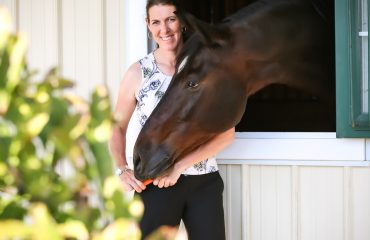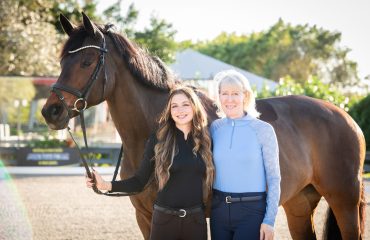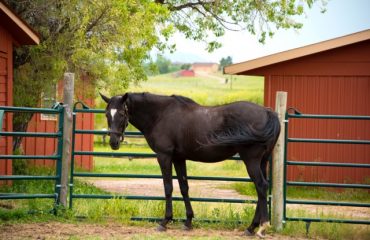By Laura Mullane
Chenoa McElvain has dreamed of competing on the U.S.A. team for the World Equestrian Games, the World Cup and the Olympics for as long as she can remember. A competitive jumper since the age of 6, Chenoa rode in her first Grand Prix when she was 13 years old. Starting at age 16, she competed in the North American Junior and Young Rider Championships, and continued competing in the NAJYRC for Zone 8 for four consecutive years, placing in the top 14 nationally for three of them.
After graduating from the University of Denver last year, Chenoa returned to Rancho Corazon, her family’s Holsteiner breeding and show jumping stable in Lemitar, New Mexico, to become the show barn manager while training and competing Rancho Corazon’s horses, including her own, full time. Under her guidance, last year was Rancho Corazon’s most successful thus far.
Sidelines recently sat down with Chenoa to talk about her horses, competition and getting closer to her goal of becoming a professional trainer.
Sidelines: You graduated from college last spring with a dual degree in sociology and archaeology. How did you balance school and showing?
Chenoa McElvain: My dad knows I’ve wanted to ride professionally my whole life, so he made a deal with me when I was in high school: He’d support my riding as long as I got my degree. So I went to college. For the most part, my horses stayed in New Mexico. My parents [Guy and Sharon McElvain] and my trainer [John McConnell] kept the horses going for me. I’d fly to shows on weekends to compete.
Sidelines: What was that like, not having your horses at school with you?
CM: It was really hard. Horses have always been a part of my life. Riding has always been my meditation — the thing I do to de-stress and re-focus. I missed the horses a lot. But I knew if they were around, I wouldn’t put as much effort into school and I really wanted to focus on college and my studies.
The one time I had a horse at school with me was for a few months my junior year after a bad fall. I was riding in a 1.20m class and came into a two-stride vertical-to-vertical. My horse was young and inexperienced and tried to do it in one stride. I tried to correct him and fit two strides in, but it was too late and he ended up flipping over and landing on top of me. It was a really bad fall, so I got lucky; I only broke my collarbone. While I was rehabbing, I brought our horse Wildthing 2 up to school with me so I could gain some confidence jumping again. I just needed to know that I could jump big fences again and not be afraid.

Chenoa on Valentina RC, with her father, Guy McElvain and groom Ulysses Rubio, winning the HITS Thermal Final $10,000 Junior/AO Classic this past winter.
(Photo by Sharon McElvain)
Sidelines: Tell us about your current string of horses.
CM: Coco Collette [a 10-year-old, 17.2 hand bay Danish Warmblood] is my Grand Prix horse. My dad imported her from Germany as a 5-year-old and competed her in the AO divisions and smaller Grand Prix. He hurt his knee last year at Thermal so I started riding her and we just clicked. We started doing Grand Prix together. We’ve done a couple World Cup qualifiers. It’s been a very interesting experience because we’re learning together. The biggest jumps that she’s ever jumped are the biggest jumps that I’ve ever jumped. It’s pretty awesome. I feel like we’re really building a partnership together and I’m proud of how far we’ve come.
Then I have two 8-year-old chestnut Hanoverian mares from Germany — Valentina RC and Voilá — that I got as 6-year-olds from Alexander Bontemps, my business partner there. They’re both Valentino babies but from different dams. I competed them very successfully in young horse classes in Germany in 2013 before bringing them to the States. They’re really huge prospects for me — they’ve won or placed in almost every 1.30m classic I’ve competed them in; they did their first 1.40m classes at Thermal, with Valentina RC placing fifth and Voilá placing third. I plan to move both of them into their first Grand Prix at the Santa Fe Summer Series [at the Equicenter de Santa Fe] this year.
I also have a Holsteiner stallion named Wall Street RC [16.3 hand gray] from Cardento. He’s another 8-year-old I got from Alexander Bontemps as a 6-year-old. I didn’t really plan to buy him. When I was over there a couple summers ago, I got a phone call about this incredible stallion. So I went to see him. I got on him and tried to do some flatwork and he was completely unrideable. But then Hilmar Meyer, the man selling him, said, “Don’t worry about the flatwork, just jump him.” So I did and — well, he was incredible. I’ve never jumped a horse that had so much power and scope. I fell in love with him. I called my dad and told him we had to get this horse.
It’s pretty exciting because he’s the first Cardento stallion to be imported to the United States, and Cardento has produced a large number of horses competing successfully in the FEI divisions. This last Thermal was his first horse show in the U.S. He’s going to need some time to develop, but he’s got the scope to go to the Olympics. I hope to move him into the 1.40m and the Grand Prix over the next year.

Valentina RC and Chenoa catching air during the HITS $10,000 Junior/AO Medium Classic.
(Photo by Sharon McElvain)
Sidelines: What trainers have influenced you the most?
CM: I’ve done clinics with some pretty big names — Melanie Smith, Julia Winkel, George Morris and Mclain Ward. And, of course, they’re incredible and you learn a lot from them. But I think the biggest influence on my riding has been John McConnell. I’ve trained with him for five years so, really, it’d be impossible for him not to have a huge impact.
I’ve recently started training with John Pearce. He’s a really amazing horseman and very good at helping me hone my mental strength, and he keeps me focused, which has been a challenge for me.
Sidelines: How so?
CM: I’m pretty hard on myself. I guess you could say that I’m a perfectionist. So if I feel like I’m messing up, it’s easy to get into my own head. John [Pearce] has taught me that, if you think something is going to happen, you can make it happen — even if you don’t want to. It’s important to be able to move on from bad days. If you have a bad round, you can’t dwell on it or it can ruin your entire week.
And there’s also just the fact that big jumps are intimidating — and I’m competing against the best of the best. John always reminds me that I’m doing it for myself, and not to worry about what everyone else is doing.
Sidelines: What would you say is your biggest advantage as a rider?
CM: I have an incredible support group around me. My family has been in the horse business for 50 years. My mom and dad are really dedicated to creating a training, sales and breeding farm that’s going to support my riding career. It’s a slower process, because I have to bring these young horses along — we’re really building from the ground up — but the advantage is that I have 17 4-year-old horses to bring along and after them I have another set of 3-year-olds. I’m very lucky that way.
Sidelines: Your father recently co-purchased Equicenter de Santa Fe, which is resurrecting the Santa Fe Summer Series this July and August. What are your plans for that?
CM: My goal is to compete my three 8-year-olds in the Grand Prix there this summer. But my involvement with Equicenter de Santa Fe is really about planning for the future of the center. Ultimately, I plan to base my training business there, while Rancho Corazon will be the center of our breeding program. So it’s going to play a huge role in the development of our horses and getting me closer to my goal to ride for the USA team.
Sidelines: What are your other short-term competition goals?
CM: I’m hoping to get Coco back into some FEI classes this fall — do some more World Cup qualifiers. Ultimately, I’d like to get on some of the European tours and start getting my name on the international lists. When I started working here after college, my goal was to spend one to two years training and competing. I really wanted to get better and start making a name for myself before I became a professional. That’s where I am now. I feel like I’m on the cusp — that things are coming together — and that’s an exciting place to be.














